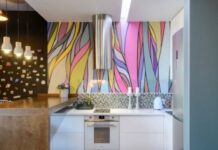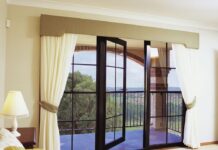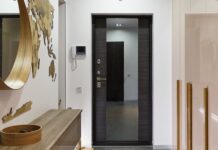For a modern private house, the façade is its business card and cover. Some homeowners want to stand out among similar buildings located on their street, others, on the contrary, decide on harmonious integration into the overall concept of the architectural features of the area. Currently, there are many options for decorating the façade of a private house building that will help satisfy any needs of the homeowner.
One of the most popular ways to decorate the facades of private households is brickwork. The brick façade perfectly combines traditional austerity, elegance and sophistication with incredible practicality. Lead brick is not only the optimal building material, but also an excellent option for decorating the front sides of buildings. Brick facades are beautiful and durable, reliable and easy to arrange, look stylish, but at the same time canonical. Brickwork is resistant to the vicissitudes of the weather – moisture, temperature changes, mechanical stress.
Let’s take a closer look at the advantages of a brick façade:
- clarity and conciseness of geometric shapes and sizes;
- brick facades perfectly “breathe” (due to the porosity of the material, brick walls perfectly remove moisture vapors from the premises);
- brick has a sufficiently high resistance to direct sunlight (due to non-fading dyes and components that make up ceramic products);
- the brick façade does not need to be additionally treated against the effects of aggressive chemical components of the atmosphere;
- the brick façade does not react sharply to temperature changes indoors and outdoors, and also calmly tolerates sudden temperature fluctuations on the street;
- the service life of the brick façade is from 50 to 100 years, depending on the type of brick, the correctness of its installation and the operating conditions of the building;
- ease of maintenance – you can simply wash the façade with water from a hose;
- resistance to wind loads;
- sufficiently low indicators of stresses and deformations, which means that there is a low probability of cracks on the façade over time;
- acceptable heat resistance (in comparison with other building and finishing materials, brick has a high resistance to fire);
- environmental friendliness of the material – does not harm humans and the environment;
- sufficiently low moisture absorption (from 6 to 30%), which means that the brick façade will be able to endure excessive moisture;
- the possibility of spot repairs (it can be quite difficult to choose the shade of the brickwork, but in general it is possible to repair the damaged area or replace a single element of the masonry);
- A wide range of architectural and design solutions – arches, niches, curvilinear surfaces, complex structures and patterns made of bricks.
The disadvantages of a brick façade include the following:
- the need to install a reinforced foundation;
- the complexity of masonry and the high cost of construction and cladding works;
- low thermal insulation properties of conventional brickwork.
The project of any building, private or public, necessarily includes a detailed description of the façade. And there are many reasons for this, because when using a non-trivial façade, you can radically improve the design and style of any architectural structure.
Variants of bricks used for the construction and decoration of private buildings
The wide demand for building and finishing bricks dictates a fairly wide range of proposals. The construction market is full of brick options of various shapes, textures, colors and, of course, cost. Conventionally, all produced bricks can be divided into two types – solid and hollow. The first option has no voids and, as a rule, is used for the construction of the foundation and basement. Hollow brick, respectively, has voids, it is much lighter in weight and has higher thermal insulation properties.
Hollow brick can be:
- general construction;
- special (refractory);
- facing.
If we divide all facing and building bricks according to the type of production and material for its manufacture, then the following types can be distinguished:
- red ceramic brick – made of special clay with firing in a kiln with a temperature of up to 1000 degrees;
- white silicate brick – made of sand and lime in an autoclave;
- pressed brick – according to the name, it is obtained by semi-dry pressing under high pressure from natural limestone, cement and dyes of various shades (the technological properties of such a brick are close to the natural material – stone, a wide palette of colors, sizes and textures, coupled with strong masonry, allows this type of brick to be a leader in its segment of finishing materials);
- clinker brick – made of refractory clay at a high firing temperature (about 1100 degrees). Such a manufacturing mode makes clinker brick strong, durable, dense, frost-resistant and moisture-resistant material for finishing building facades. In Europe and America, the use of clinker bricks is very common, for more than two centuries this material has been used for the construction and decoration of buildings. In our country, this type of brick is now at the peak of popularity.
In most cases, the choice of a particular type of brick for finishing home ownership falls on the shoulders of the owners, but a professional architect can really choose the best budget solution for finishing the façade of a house in a certain area with its own climatic features.
To date, the design of the façade of a private house can be very diverse, the choice of finishing materials is truly wide, and the pricing policy in this segment of goods offers options for any size of the budget allocated for the decoration of the building. Bricks for exterior decoration, regardless of the type of production, can be of different sizes, shapes (traditional, with rounded edges or imitations of chips).
Painting brick facades – features of a popular type of decoration
Not all designers and homeowners have an unambiguous attitude to brickwork as a way to decorate building facades. Some seek to emphasize in every possible way the features of the brickwork, its texture and shade. Others, on the contrary, try to disguise the natural appearance of the brick. Painting the façade of a building is a great way not only to give the desired shade to the entire structure, but also to hide the flaws and defects of the old masonry.
But any delay has a downside – improper painting of the walls can lead to a violation of the main advantage of brickwork – excellent vapor permeability. If you do not take into account the rules of what and how it is necessary to paint brick walls, you can get a damp structure from a perfectly “breathing” building with the prospect of mold breeding.
Before you start painting the façade of your household, check out some simple rules and useful tips:
- You must be 100% sure of the expediency of painting the façade of your private house. In the market of building finishing materials, there are enough options for bricks of various shades, which can safely do without staining and retain its original appearance, shade and shape for many years. But the coloring will need to be periodically updated (every 3-4 years to give an aesthetically pleasing appearance of the building);
- In the future, if you change your mind, it will be extremely difficult to remove paint from a brick wall, the porous structure of the material allows the paint to be unevenly absorbed into the surface. Thus, the options for decorating the façade of your home are significantly reduced;
- It is impossible to paint the newly erected walls, it is necessary to wait a year to complete all the processes of weathering, leaching and drying of the brickwork. Painting fresh brickwork, you are at great risk of getting defects in the paint layer in the shortest possible time;
- The difficulty of painting is not in the process of applying paint to a brick wall, but in preparing the surface for this activity. It is necessary to remove all traces of existing mold using special tools. The surface on which the paint will be applied must be completely dry. The moisture remaining in the pores of the material can subsequently lead to the formation of cracks and chips in the painting and swelling of the layer. It is best to paint the brick in summer, in hot and dry weather. Brickwork should be completely free of dust – do not use acidic solutions, ordinary soapy water is ideal. All brick walls are subject to mandatory priming before painting (choose a primer that is resistant to an alkaline environment).
As a rule, old brickwork is painted for several possible reasons
- change in the color or shade of the façade of the household;
- masking defects in old brick walls;
- creating a balanced combination of old walls with new extensions;
- giving a more modern look to the house with the addition of trendy decorative elements, designs or materials.
The painting of the façade must be taken seriously and choose paint for exterior work according to the following criteria:
- the paint layer should have a porous structure in order to preserve the vapor permeability of the walls of your household;
- have a sufficiently high moisture resistance;
- do not react to direct sunlight;
- have high resistance to alkaline effects;
- Maintain the original appearance for a long time.
Currently, there are many options for façade paints on sale, intended for application, both on new and old surfaces of brick walls. All information about the technological properties is on the label of the paint container, do not trust the sellers and familiarize yourself with this very useful information.
Original shapes and colors of brick facades
The façade brick itself is durable, beautiful and practical. But the method of presenting this finishing material is also important to create an original appearance of home ownership. The final result of the finishing of the building depends not only on the literacy and accuracy of the installation, but also on the originality of the laying of the material, its unusual colors or the way the colors are arranged among themselves.
There are many options for the execution of decorative brickwork, but it is obvious that the cost of installing any of the methods will cost more than the classic construction of finishing surfaces. But, if you want to stand out from the general mass of similar private households, it makes sense to spend a little money in order to enjoy the fruits of your labor for many years and receive admiring compliments from your neighbors on the street.
For example, the so-called Brandenburg masonry is a great way to decorate the façade of your building, especially if you use sufficiently contrasting combinations of light and dark bricks to make a pattern.
Facing brick is a very malleable material. It is not difficult to decorate facades with non-standard shapes – semicircles, arches and wavy structural elements.
Интересного внешнего вида фасада здания можно добиться при комбинировании кирпичной кладки с блочным выполнением облицовки стен. Добиться подобного эффекта несложно – часть кирпичей в нужном вам порядке покрывается так называемой бетонной «шубой» и с помощью контрастно-светлой затирки элементы выделяются.
The combination of two contrasting shades of brick within the cladding of one façade of a household can create an interesting appearance.
A simple technique for decorating a brick façade is the selection with the help of bricks of window and door openings, corners of the building, columns and other structural elements that are distinctive from the main color of the material.
An interesting and easy to install way to create an original image of the façade of a household is the use of bricks of various shades from one segment of the color palette. As a result, it inevitably turns out to be quite colorful and memorable appearance of brickwork.
Sometimes, to create the original façade of the building, it is enough to purchase facing bricks of an unusual shade. Its cost will be slightly higher than the standard reddish-reddish shades, but you will have the opportunity not only to stand out among the neighboring buildings, but also to choose the most suitable shade of tiles, window and door openings to create a truly harmonious and attractive image of the exterior of your home.
If not only the façade cladding, but additional buildings, gazebos or canopies, laying out steps and garden paths in front of your household is made of clinker bricks of a bright or non-trivial shade – the result can be a very harmonious and attractive image of the entire architectural ensemble.















































